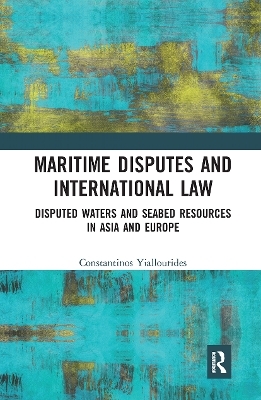
Maritime Disputes and International Law
Routledge (Verlag)
978-1-032-24113-5 (ISBN)
Dr Constantinos Yiallourides is the Arthur Watts Research Fellow in Public International Law at the British Institute of International and Comparative Law, specialising in maritime and territorial disputes. He advises States, international organisations and other entities on matters of international law.
Table of contents
Table of contents
List of figures
List of cases
List of abbreviations
Preface
Acknowledgements
Chapter 1: Introduction
Background to this book
International cooperation over seabed activities? Why now?
Goals of this book
Structure of this book
Chapter 2: The International Law of Maritime Boundary Delimitation
Introduction
The role of seabed activities in the development of the law of the sea
Assessing the efforts to codify the law of maritime delimitation
The 1958 United Nations Conference on the Law of the Sea
The Third United Nations Conference on the Law of the Sea (1973–1982)
Maritime boundary delimitation before international courts and tribunals
Introduction
The equitable principles/relevant circumstances method
Moving towards a more certain delimitation methodology? The increasing importance of equidistance
Drawing a single EEZ and continental shelf boundary
The prominence of geography
Relevant circumstances when drawing a single EEZ/continental shelf boundary
Conclusion
Chapter 3: The Aegean Sea Maritime Delimitation Dispute
Introduction
Geographical characteristics
Maritime claims and applicable law
Territorial sea claims
Continental shelf claims
EEZ claims
Method of delimitation advanced by Greece
Method of delimitation advanced by Turkey
Questions of maritime delimitation in the Aegean Sea
Zone-generating capacity of islands
‘Rocks’
‘Cannot sustain human habitation or economic life of their own’
The role and effect of islands in maritime boundary delimitation
Introduction
Discernible principles or approaches
Discounting islands as base points
Granting islands reduced effect
Island enclaves
Combination of approaches
Implications for the Aegean Sea
Seabed resources in the Aegean Sea
Conclusion
Chapter 4: The East China Sea Maritime Delimitation Dispute
Introduction
Geographical and geomorphological characteristics
Maritime claims and applicable law
China
Taiwan
Japan
South Korea
Delimitation questions in the East China Sea
China’s outer continental shelf submission to the CLCS
The role of geology and geomorphology in maritime boundary delimitation
Jurisprudence
State practice
Timor Sea
Japan’s practice towards South Korea
Senkaku/Diaoyu islands and Article 121(3) of UNCLOS
Introduction
Application of Article 121(3) of UNCLOS to Senkaku/Diaoyu islands
Effect of Senkaku/Diaoyu islands on maritime boundary delimitation
Oil and gas development in the East China Sea
Conclusion
Chapter 5: Unilateral Seabed Activities in Disputed Waters
Introduction
Maritime spaces under overlapping ‘sovereign rights’
Rights and obligations of States pending resolution of overlapping claims
Obligation to make every effort to conclude provisional arrangements
Obligation to make every effort not to aggravate the dispute
Lessons to be learned
Objective criteria are useful but much depends on the context
More scope for unilateralism?
Meaningful responses against unilateral petroleum activities
Impact on energy investments
Conclusion
Chapter 6: Joint Development of Seabed Resources in Disputed Maritime Areas
Introduction
The basic concept of joint development
Joint development and cross-border unitisation
The functional character of joint development
The legal foundations of joint development
EEZ and continental shelf rights
Joint development in the law of the sea
Joint development and customary international law
Joint development in State practice
Single state authority
Joint authority
Compulsory joint venture
Conclusion
Chapter 7: Beyond Delimitation Questions in the East China Sea and the Aegean
Introduction
Negotiating joint development in the East China Sea and the Aegean
Recognition of the prima facie validity of competing claims
Political will
Determining the zone of cooperation
A joint development zone in the Aegean?
Choice of legal framework applicable to the joint development zone: options
Single state model
Joint authority model
Preferable approach: ‘divide and manage’
Institutional set-up
Key objectives of the joint commission
Orderly and timely exploration and exploitation of petroleum
Prevent or mitigate conflicts between petroleum activities and other marine uses
Protection and preservation of the marine environment
Chapter 8: Conclusion
Index
| Erscheinungsdatum | 14.12.2021 |
|---|---|
| Verlagsort | London |
| Sprache | englisch |
| Maße | 156 x 234 mm |
| Gewicht | 426 g |
| Themenwelt | Recht / Steuern ► EU / Internationales Recht |
| Sozialwissenschaften ► Politik / Verwaltung | |
| ISBN-10 | 1-032-24113-6 / 1032241136 |
| ISBN-13 | 978-1-032-24113-5 / 9781032241135 |
| Zustand | Neuware |
| Haben Sie eine Frage zum Produkt? |
aus dem Bereich


